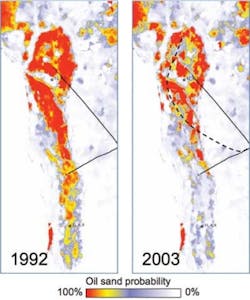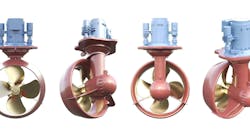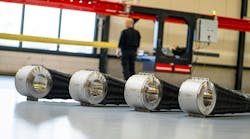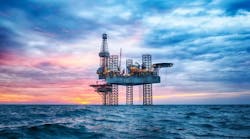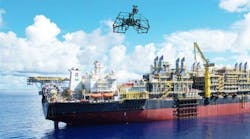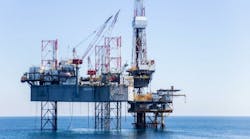Mike Wahlberg - Gulf Copper
Scott Williams - Transocean
In the recent upgrade of a semisubmersible drilling rig offshore Namibia, Texas-based Gulf Copper and Transocean teamed up to carry out the required work on site with an unorthodox but effective method referred to as “shipyard in a box.”
Semisubmersibles, drillships, and jackups are called mobile offshore drilling units for good reason. They move from region to region, country to country, continent to continent, sometimes traveling thousands of miles. When a rig changes locations, a change in rig equipment is often required to satisfy specific operator requirements and/or formation demands.
Rig service companies can repair, modify, upgrade, or completely refurbish a rig prior to its move. In many cases, however, there is not enough time to send a rig into a shipyard for equipment upgrades or maintenance before the rig needs to be on its next drilling location. In other cases, the rig is working in such a remote location that little or no shipyard facilities are available at all.
In these situations, select rig service companies can essentially bring the shipyard to the rig, whether the rig is mobilizing from one area to another or it is in a remote location in a country with little or no docking or port facilities.
Challenges overcome
During a recent project, Transocean needed to perform rig upgrades and maintenance on its semisubmersible drilling rigGSF Rig 140 prior to beginning a new drilling contract offshore Equatorial Guinea. Gulf Copper was contracted to perform much of the work.
Several events tested the companies’ flexibility and adaptability before the project even began. The project was originally to be performed offshore Port Gentil, Gabon, during summer 2009. However, it was decided to move the rig to Walvis Bay, Namibia, which created a logistical challenge, since equipment and material were either en route to Port Gentil or already on the ground. Much of it had to be re-routed and doing that required intercepting material transits, removing equipment from ships before they arrived at Port Gentil, and diverting the equipment to Walvis Bay.
Semisubmersible drilling rigGSF Rig 140 was upgraded while anchored offshore Namibia, Africa.
The facility at Walvis Bay is not a shipyard, but actually a mineral loading and offloading dock operated by the port authority NAMPORT (Namibian Port Authority). It was not designed for shipyard work, but it was the only location along the quayside that had water deep enough to accommodateGSF Rig 140. Another Transocean semisubmersible, Sedneth 701, already was at quayside having work performed.
The Transocean project manager arrived in Walvis Bay in June 2009 and began setting up contacts and contracts, negotiating berth space, and Gulf Copper’s involvement.GSF Rig 140 arrived the first part of August. Gulf Copper’s Global Services project manager arrived ahead of the other employees and began working with Transocean to implement the project plan and schedule.
Tool houses and tool rooms that were built at Gulf Copper’s Port Arthur, Texas, facility were shipped to Walvis Bay, unloaded and inventoried. Gulf Copper employees were used as lead hands, managing and supervising tasks, while being supplemented with Namibian craftsmen, welders, and fitters.
Transocean located and contracted several local charter boats, built a scaffold stair tower onGSF Rig 140, which was anchored in the bay, and began shuttling workers to the rig. This resulted in a 30-day head start on some of the tasks by performing preliminary work and supervising local craftsmen from Walvis Bay.
GSF Rig 140 work scope
GSF Rig 140 was only about two years out of major shipyard refurbishment and was in good condition. Consequently, about 90% of the work scope was customer make-ready for the next contract. The scope included new equipment as well as equipment upgrades and overhauls. The mud pumps and the drawworks were overhauled, a complete re-bolt of the derrick’s structural members was performed, and about 20% of the derrick’s structural steel was replaced. A significant portion of the high-pressure mud pump piping system was replaced, and a new shale shaker and cuttings drier system were installed. All three of the rig’s cranes were overhauled and a new boom was installed on one of the cranes.
Two workover reels for manipulating, retrieving, and managing existing subsea tree systems were installed on the rig. Installation of the workover reels and piping was challenging to overcome, since it was new equipment not typically outfitted on the rig.
Additionally, five 20-ton (18-metric ton) tuggers were installed on all four sides of the rig and inside its moonpool. The system, used for installing subsea equipment, also was a new addition to the rig.
A new water maker also was installed to convert seawater to fresh water.
Work in Walvis Bay
Considerable preliminary, preparatory, and prefabrication work and some minor overhaul activity were performed while the rig was anchored offshore. For example, one of the mud pumps was overhauled offshore, a crane boom was replaced, and the foundations for the workover reels were installed. The reels themselves could not be sent offshore for installation due to lack of a suitable work barge, which created the logistical challenge of working on the rig while it was anchored offshore. The team waited until the rig was at quayside to install the workover reels, since they weighed about 70 tons (64 metric tons) each.
Another challenge was the limited number of workers that could be on the rig at any given time while it was anchored offshore. Typically, 150 people are allowed on this rig during normal operating conditions. Since the rig was neither under contract nor operating on a well location, it had been down-manned significantly. This limit is due to the life saving capacity of the lifeboats. Even so, only 60 additional personnel were allowed on the rig while it was at anchorage.
As such, the team focused and targeted specific activities that significantly affected the work scope and schedule when the rig arrived at quayside. In addition to installing the workover reel foundations and the crane boom, other work conducted offshore included cutting out existing piping systems in preparation for new high-pressure piping.
Quayside
The quayside facility was not a shipyard. Fortunately, the team was able to source a 150- ton (136-metric ton) rental crane that had just enough reach and capacity to get most of the new equipment to the rig’s deck so it could be handled by one of the rig’s cranes. In other cases, the rig’s cranes were used when available.
Still, challenges remained. At any given time, at least one of the cranes was out of commission while being overhauled. In some instances, equipment was moved from quayside to the opposite side of the rig via small floating platforms and then lifted by one of the rig’s cranes.
Shipyard in a box
Gulf Copper, partnering with Transocean, basically created a shipyard in a box, necessary because of the lack of proper shipyard facilities in the remote location. Essentially, in the case ofGSF Rig 140, the companies established a shipyard at a public port facility. The correct equipment and the right amount of supplies were crucial.
For example, the team shipped welding machines and a plasma burner, the latter because there were several stainless steel welding jobs that were to be performed. Because high-pressure piping was involved, a pre-determined number of tig welding rigs were shipped.
The manifest of equipment and supplies was comprehensive, to say the least. Among safety equipment the list included hard hats, leather work gloves, tig gloves, 8-, 12-, 16- and 20-ft (2.4, 3.7, 4.9, and 6.1 m) ladders, goggles, ear plugs, a portable gas detector, and air horns for fire watchmen.
The list of small tools included several types and weights of hammers, chisels, scissors, wrenches, files, drills and drill bits, clamps, wire brushes, measuring tapes, screwdrivers, flashlights, even a plumbers snake.
Miscellaneous supplies included batteries, flashlight bulbs, electrical tape, duct tape, gear grease, tarps, and writing instruments in the form of a gross each of black and blue markers.
It is all in the planning and the execution, with the right partners. The companies involved in the project had a vested interest in making it work. The job was completed in less than the allocated number of days and under budget.
